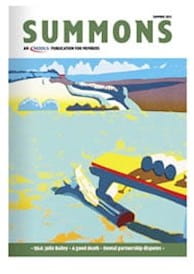AT the end of a holiday in Nepal in March 1987 I decided to make a visit to a local hospital and was directed to the Tribhuvan University Teaching Hospital in Kathmandu. Here I met Rakesh Prasad who, at the time, was the only person in Nepal trained in modern microsurgical ear techniques. He introduced me to his legendary father, Dr LN Prasad, who after gaining diplomas in ophthalmology and ENT from the Royal College of Surgeons of England became for a time the only eye and ENT surgeon in Nepal.
Dr LN Prasad told me of a disability survey which he had directed in 1981 (the Year of the Disabled) and of his surprise that deafness was the single greatest disability in Nepal. He had a vision of bringing ear care to people living outside the reach of the Kathmandu valley but with only his son and no funds for equipment he needed help.
Ear surgery camps
I offered to bring a British team of two surgeons, an anaesthetist and two nurses to join with a Nepalese team in order to conduct an outpatient and surgery camp twice a year in the extremes of the country. This idea was met with great enthusiasm and after setting up a charity and a limited company and raising the funds for sufficient equipment to run two operating tables, the first BRINOS ear surgery camp was held in Pokhara in 1989.
In subsequent years we have worked at both the eastern and western ends of Nepal in 50 camps and have examined over 40,000 people and performed over 4,000 major ear operations. The last 38 camps have been conducted in the southwestern Terai at Nepalgunj, mostly in an old ‘Victorian’ palace which originally had been given by a family to house an eye hospital.
Conditions in the hospital are basic. The recovery ward is on the first floor adjacent to the theatre but the main ward is temporarily located in a large bicycle shed. The electricity supply is supported by a generator but there is no running water, instead two large plastic vats are supervised by a waterman. Since 2008 we have found space for a third operating table. The camps have provided an ongoing surgical training programme for young Nepalese ENT surgeons, nurses, and technicians.
Bottom-up care
It was pointed out to us early on in the project that we were treating the end product of ear disease and that we should be concentrating on prevention. In 1991 BRINOS conducted a nationwide survey of deafness and ear disease in which 16,000 people were surveyed by a joint British and Nepalese team. The survey found that 14.2 per cent of the population of Nepal were significantly deaf (2.7m individuals including 1.9m school age children out of a population of 19m) and 860,000 individuals had middle ear infection. Of the 395 individuals aware of ear problems who had attended a local health clinic, two-thirds were dissatisfied with their treatment. We also found that 50 per cent of all ear disease is preventable.
Initially we thought that by training general health workers in ear disease and providing them with the necessary equipment we could reach out to the people at village level. This was not successful as ear disease came low on their priorities. There was a vital link missing. So in 2000 we established community ear assistants (CEAs), who are health workers trained exclusively in ear disease.
CEAs are equipped with examination instruments, portable re-chargeable suckers and field audiometers and, in turn, train female volunteer ear care assistants (now numbering over 1,000) who live in the villages covered by them. The care is ‘bottom up’. The volunteers, who teach ear care and disease prevention (to 16,000 villagers in the last five years), find the patients and call in the CEAs who then diagnose and treat common ear conditions. Before this time villagers were totally unaware of the significance of deafness or ear discharge; they assumed it was either normal or their burden in life. Those cases considered for surgery join our ‘waiting list’ which is never longer than six months. The aftercare of the operated patient is entrusted to the CEAs
Success and new challenges
Since 2000 over 98,000 school children have been screened for deafness and ear disease, 86,000 patients have been examined in the villages and a further 27,000 in the daily Nepalgunj clinic where in the last five years 1,200 hearing aids have been fitted. This form of primary ear care delivery has been accepted as the model for the country by the Society of Nepalese ENT surgeons and the project has contributed to two important developments: the people of Nepal are now much more aware that ear disease can be treated and there has been a marked increase in young doctors wishing to study ENT.
But there are additional challenges. Recognising the limited space in which our CEAs perform their vital work, BRINOS and our sister NGO the BRINOS Ear Health Community Service have acquired a site on which to build the BRINOS Ear Care Centre. Preliminary site works have started and BRINOS is actively seeking funds to continue the work. For further details please visit www.brinos.org.uk
Mr Neil Weir MD MA FRCS is an ENT surgeon and founder director of BRINOS
MDDUS was the principal sponsor of the 2013 BMJ Group Awards at which BRINOS was named both Karen Woo Surgical Team of the Year and Medical Team of the Year
This article appears in the Summer 2013 issue of Summons
This page was correct at the time of publication. Any guidance is intended as general guidance for members only. If you are a member and need specific advice relating to your own circumstances, please contact one of our advisers.
Read more from this issue of Insight

Save this article
Save this article to a list of favourite articles which members can access in their account.
Save to library